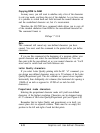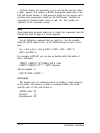
Sending information to the LQ-2500
The printer loads characters in the print style (Letter Quality draft, or
proportional) and font (Roman, Sans Serif, Courier, Prestige, or Script)
that the printer is currently using. It also records whether italic or script
(either superscript or subscript) is turned on. This means that if you
want to print a character in the italic mode, for example, you must have
the italic mode turned on when you define the character.
The command to define characters is one of the most complex in the
LQ-2500s repertoire. The format of the command is:
ESCape ‘&” 0
nl n2 d0 dl d2
data
The EXape ‘&” is simple enough. The 0 (which is ASCll code 0, not
the numeral zero in quotation marks) allows for future enhancements.
At this time it is always ASCII 0.
With the LQ, you can define many characters with a single
command. The values
nl
and
n2
are the ASCII codes of the first and
last characters you are defining. If you are defining only one character,
nl
and
n2
are the same. You can use any codes between 32 and 127
decimal for
nl
and
n2,
but it is best not to define decimal 32, which is
the code for a space. Also, you can use letters in quotation marks
instead of ASCII numbers for
nl
and
n2.
For instance, if you wanted to redefine the characters A through 2,
nl
would be “A” (or ASCII code 65) and
n2
would be ‘Z” (or ASCII code
90). So the command ESCape ‘&” 0 ‘AZ” (followed by the appropriate
data) would replace the entire alphabet of capital letters.
Following the specification of the range of characters to be defined are
three data bytes
(d0-d2)
that specify the width of the character and the
space around it. The left space (in dot columns) is specified by
do,
and
the right space is specified by d2. The second byte
(dl)
specifies the
number of columns of dots that are printed to make up the character.
By varying the width of the character itself and the spaces around it,
you can create proportional-width characters that print at draft speed.
Table 6-3 shows the maximum values for these bytes.
Graphics and Userdefined Characters
6-15


















